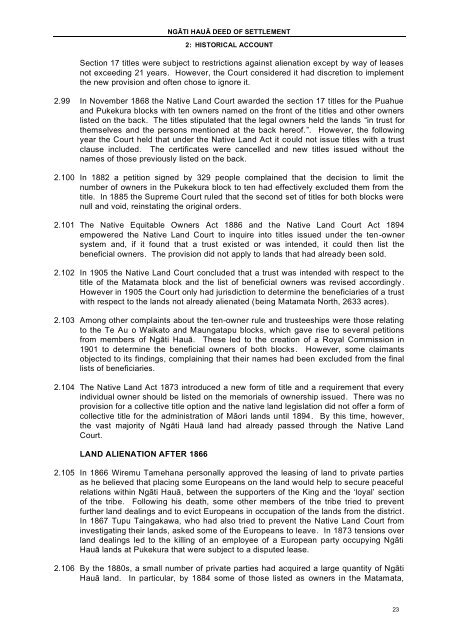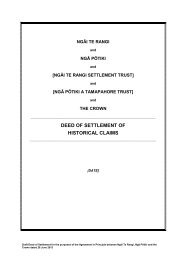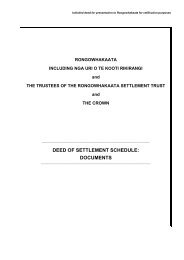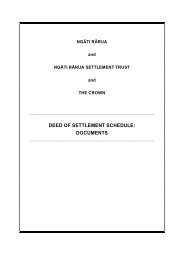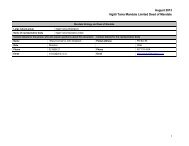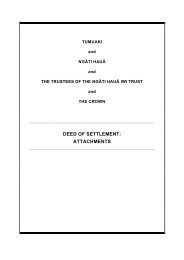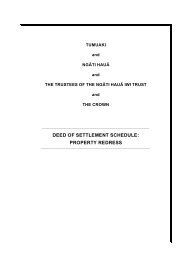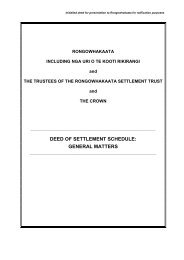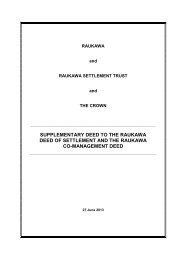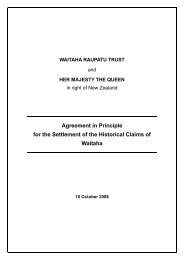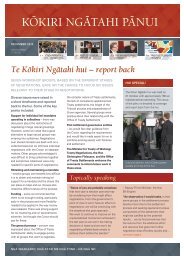Ngati Haua Deed of Settlement - Terabyte Interactive
Ngati Haua Deed of Settlement - Terabyte Interactive
Ngati Haua Deed of Settlement - Terabyte Interactive
You also want an ePaper? Increase the reach of your titles
YUMPU automatically turns print PDFs into web optimized ePapers that Google loves.
NGĀTI HAUĀ DEED OF SETTLEMENT2: HISTORICAL ACCOUNTSection 17 titles were subject to restrictions against alienation except by way <strong>of</strong> leasesnot exceeding 21 years. However, the Court considered it had discretion to implementthe new provision and <strong>of</strong>ten chose to ignore it.2.99 In November 1868 the Native Land Court awarded the section 17 titles for the Puahueand Pukekura blocks with ten owners named on the front <strong>of</strong> the titles and other ownerslisted on the back. The titles stipulated that the legal owners held the lands “in trust forthemselves and the persons mentioned at the back here<strong>of</strong>.”. However, the followingyear the Court held that under the Native Land Act it could not issue titles with a trustclause included. The certificates were cancelled and new titles issued without thenames <strong>of</strong> those previously listed on the back.2.100 In 1882 a petition signed by 329 people complained that the decision to limit thenumber <strong>of</strong> owners in the Pukekura block to ten had effectively excluded them from thetitle. In 1885 the Supreme Court ruled that the second set <strong>of</strong> titles for both blocks werenull and void, reinstating the original orders.2.101 The Native Equitable Owners Act 1886 and the Native Land Court Act 1894empowered the Native Land Court to inquire into titles issued under the ten -ownersystem and, if it found that a trust existed or was intended, it could then list thebeneficial owners. The provision did not apply to lands that had already been sold.2.102 In 1905 the Native Land Court concluded that a trust was intended with respect to thetitle <strong>of</strong> the Matamata block and the list <strong>of</strong> beneficial owners was revised accordingly .However in 1905 the Court only had jurisdiction to determine the beneficiaries <strong>of</strong> a trustwith respect to the lands not already alienated (being Matamata North, 2633 acres).2.103 Among other complaints about the ten-owner rule and trusteeships were those relatingto the Te Au o Waikato and Maungatapu blocks, which gave rise to several petitionsfrom members <strong>of</strong> Ngāti Hauā. These led to the creation <strong>of</strong> a Royal Commission in1901 to determine the beneficial owners <strong>of</strong> both blocks. However, some claimantsobjected to its findings, complaining that their names had been excluded from the finallists <strong>of</strong> beneficiaries.2.104 The Native Land Act 1873 introduced a new form <strong>of</strong> title and a requirement that everyindividual owner should be listed on the memorials <strong>of</strong> ownership issued. There was noprovision for a collective title option and the native land legislation did not <strong>of</strong>fer a form <strong>of</strong>collective title for the administration <strong>of</strong> Māori lands until 1894. By this time, however,the vast majority <strong>of</strong> Ngāti Hauā land had already passed through the Native LandCourt.LAND ALIENATION AFTER 18662.105 In 1866 Wiremu Tamehana personally approved the leasing <strong>of</strong> land to private partiesas he believed that placing some Europeans on the land would help to secure peacefulrelations within Ngāti Hauā, between the supporters <strong>of</strong> the King and the ‘loyal’ section<strong>of</strong> the tribe. Following his death, some other members <strong>of</strong> the tribe tried to preventfurther land dealings and to evict Europeans in occupation <strong>of</strong> the lands from the district.In 1867 Tupu Taingakawa, who had also tried to prevent the Native Land Court frominvestigating their lands, asked some <strong>of</strong> the Europeans to leave. In 1873 tensions overland dealings led to the killing <strong>of</strong> an employee <strong>of</strong> a European party occupying NgātiHauā lands at Pukekura that were subject to a disputed lease.2.106 By the 1880s, a small number <strong>of</strong> private parties had acquired a large quantity <strong>of</strong> NgātiHauā land. In particular, by 1884 some <strong>of</strong> those listed as owners in the Matamata,23


